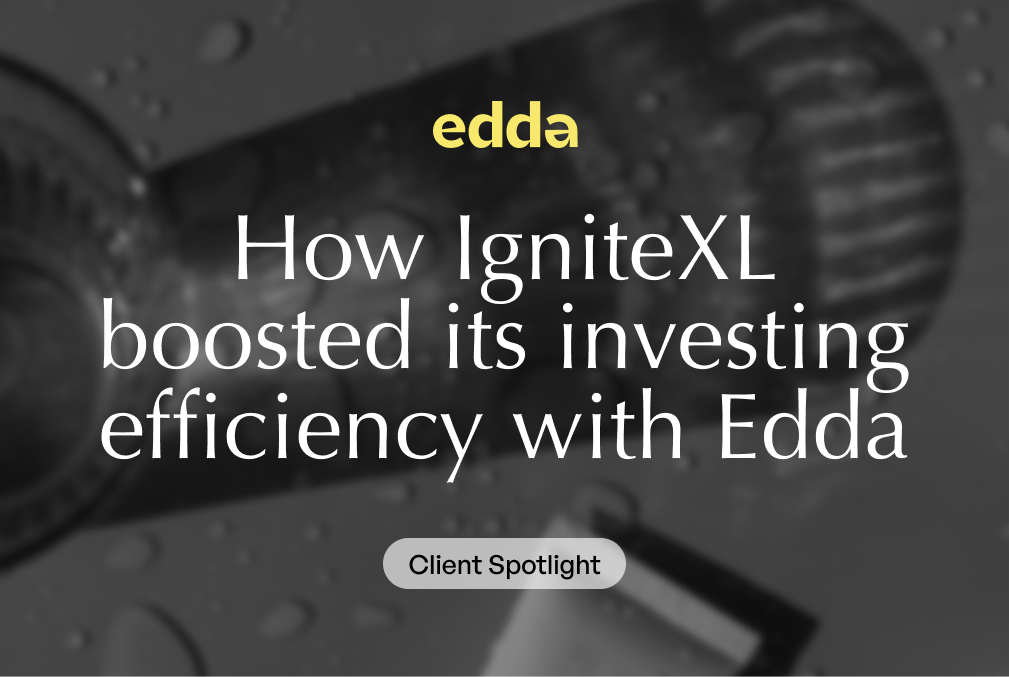Venture capital (VC) is the lifeblood for many startups, fueling their growth and innovation. While the venture capital ecosystem has its own intricacies, there are specific metrics and nuances that play a pivotal role in its functioning.
One such metric that often goes unnoticed but holds profound importance is the distributed paid-in capital (DPI). This article takes you on an exploratory journey into the world of venture capital DPI, elucidating its significance, its impact on limited partner (LP) relationships, the rise of the LPs portal, and the relevance of business venture software like Edda.
Understanding Venture Capital DPI
VC DPI serves as a pivotal benchmark within the venture capital and private equity landscape. It facilitates a comprehensive assessment of the capital that LPs have retrieved in comparison to their initial investment commitment in a particular fund.
From a mathematical standpoint, DPI is represented as:
DPI = Total distributions to LPs / Total paid-in capital by LPs
Yet, the significance of DPI transcends its numerical value. Acting as a financial pulse, it is imperative for understanding the health, profitability, and performance trajectory of a VC firm. It’s an essential instrument for stakeholders to ascertain the return on their investments and to evaluate the overall success of a VC firm’s investment strategies.
The Pervasive Significance of VC DPI
Venture Capital DPI holds multifaceted significance:
Performance Metrics
DPI stands as a testament to a fund’s financial performance over its lifespan. A DPI surpassing 1 indicates LPs have received distributions that eclipse their paid-in capital, suggesting successful investment strategies. Conversely, a DPI below 1 signals that LPs are still awaiting returns matching their initial commitments.
For example:
Imagine a venture capital fund that started five years ago. Since its inception, the LPs have collectively contributed $100 million to the fund, hoping for lucrative returns from the fund’s investments in promising startups.
Fast forward to today. The LPs have received distributions totaling $130 million from the exits of some of the portfolio companies and dividend payments. To assess the fund’s performance, the LPs decide to calculate the DPI.
Using the formula for DPI they find:
DPI = 130/ 100 = 1.3
A DPI of 1.3 signifies that for every dollar the LPs invested, they’ve received $1.30 in return, exceeding their original commitment by 30%. This DPI value, surpassing 1, indicates that the fund has effectively employed its investment strategies, yielding positive returns to its LPs. Based on this performance metric, the LPs can confidently infer that their investment was well-placed, and they might be more inclined to consider reinvesting in the next fund managed by the same VC firm.
Decision Making
The DPI metric emerges as an invaluable tool for LPs as they navigate potential reinvestments. When considering reinvesting in newer funds managed by a familiar VC firm, DPI provides a historical context of the firm’s performance.
A robust DPI figure is indicative of a firm’s successful return history, making it an enticing proposition for continued investment. Conversely, a declining DPI can serve as a cautionary signal, prompting LPs to scrutinize the reasons for diminished returns before making further financial commitments.
For example:
“Investor Alpha” is considering reinvesting in “VC Firm Y’s” upcoming “Fund Z.” To make an informed decision, they review the DPI of the firm’s previous “Fund W” and find a promising figure of 1.5, indicating a 150% return on their initial capital.
On the other hand, “Investor Beta,” examining an older “Fund V,” discovers a DPI of 0.8, suggesting they only received 80% of their initial investment back.
Using these DPI figures, Investor Alpha is inclined towards reinvesting, recognizing the recent success of Fund W. Meanwhile, Investor Beta, recalling the underperformance of Fund V, approaches the new investment opportunity with caution, seeking to understand the reasons behind the earlier fund’s dip before committing to Fund Z.
Comparative Analysis
DPI provides LPs with a mechanism to comparatively evaluate the performance of diverse funds. By leveraging this metric, LPs can measure a specific fund’s results against its peers or even against broader industry benchmarks. This holistic perspective, granted by DPI, allows LPs to discern where a particular fund stands amidst the competitive dynamics of the VC industry, ensuring more informed investment decisions.
For example:
“Investor Charlie” holds stakes in three different VC funds: “Fund X,” “Fund Y,” and “Fund Z.” To assess their performance, Charlie uses DPI as a reference point.
“Fund X” showcases a DPI of 1.2, outperforming the industry average of 1.0. “Fund Y” matches the benchmark with a DPI of 1.0, while “Fund Z” trails with a 0.9 score.
Using DPI for a comparative analysis, Investor Charlie recognizes the superior performance of Fund X, views Fund Y as on par with industry norms, and identifies potential concerns with Fund Z, prompting a deeper dive into the latter’s strategy and decisions.
Forecasting Returns
DPI isn’t merely a retrospective metric; it also holds predictive power. By analyzing current and past DPI values, limited partners (LPs) can extrapolate potential future returns, offering them a glimpse into the anticipated performance of their investments. Such projections, rooted in DPI, become instrumental for LPs as they strategize for long-term financial growth and optimize their portfolio allocations.
For example:
“Investor Emma” is evaluating her five-year financial strategy and her positions in two VC funds: “Alpha Ventures” and “Beta Capital.” She notes the following:
“Alpha Ventures” has a consistently rising DPI over the past three years.
“Beta Capital,” however, shows a fluctuating DPI with no clear upward trend.
Using DPI as a forecasting tool, Emma predicts that her investments in “Alpha Ventures” will likely continue to yield positive returns, aligning with her long-term financial objectives. On the other hand, the unpredictable nature of “Beta Capital’s” DPI prompts her to consider reallocating some funds to other more promising ventures.
VC DPI and Its Profound Impact on LP Relationships
The symbiotic relationship between venture capitalists and their limited partners is crucial. DPI remains instrumental in molding this alliance:
- Transparency and Trust: Regular DPI updates epitomize transparency, forging trust even when funds waver.
- Communication Conduit: DPI discussions serve as a conduit for VC firms to elucidate their strategies, triumphs, and setbacks, fostering a two-way dialogue.
- Informed Decision Making: DPI equips LPs with the arsenal they need for informed future investments, solidifying the partnership’s foundation.
- Alignment of Interests: Sharing DPI metrics ensures that both VCs and LPs are on the same page, with aligned interests and expectations.
The Digital Evolution: Rise of LP Portals
With digital transformation sweeping industries, VC hasn’t remained untouched. The advent of LP portals exemplifies this shift, offering LPs a digital platform for metrics access, including DPI.
Advantages of LP Portals:
- Real-time Access: Instant, real-time access to metrics, including VC DPI.
- Efficient Communication: A streamlined channel fostering efficient VC-LP interactions.
- Data Security: Robust measures to ensure data confidentiality and integrity.
- Interactive Analysis: Advanced features like analytics tools, predictive models, and interactive charts to deepen LP understanding.
- Ease of Collaboration: Portals facilitate effortless collaboration between LPs and VC firms, allowing them to share insights, provide feedback, and strategize for the future.
Spotlight: Edda’s LP Portal
Edda, a popular venture capital management software, offers a premier LP Portal. Edda’s LP Portal stands out in the VC space, offering tailored solutions to streamline the management and presentation of DPI metrics. While VC DPI can often be intricate and challenging to grasp, Edda’s LP Portal simplifies this complexity by providing a user-friendly interface and transparent metrics. It’s this attention to clarity and transparency that ensures LPs are always in the loop, fostering an atmosphere of trust and alignment of interests.
The rise of digital platforms like Edda’s portfolio management tool and LP Portal signifies the industry’s commitment to harnessing the power of technology to foster better communication, real-time updates, and in-depth analysis. Edda’s LP Portal is not just a tool; it’s a bridge, ensuring that the intricate dynamics of venture capital are made transparent, and fostering stronger relationships between VCs and their LPs.
In the fast-evolving arena of venture capital, tools that prioritize transparency, efficiency, and user-centric design, like Edda’s LP Portal, will undoubtedly play an instrumental role in shaping the future of VC-LP relationships.









